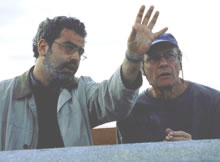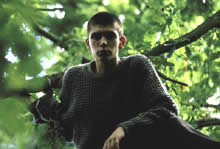| The film revels in the freedom afforded it by using a Digital format. Does the format make the process any easier?
Using DV freed up both the camera and the actors. Because we went for a lightweight handheld camera it meant we could improvise with it more. The idea was not to restrict the actors to hitting their marks and for the camera to find them rather than the other way round. Because of the cheapness of tape we could shoot scenes all the way through from various angles, rather than stopping and starting - so that the actors could keep their rhythm going. We could also start some scenes with a few minutes of improvisation that would then segue into the scene proper without having to stop and get the camera going. There was a great liberation in that which we couldn't have afforded on film.
Also the fact that we shot on a small camera without tripods or tracks or dollies made the camera a far less imposing presence for the actors, more a part of the scene rather than something in front of which the scene was played. As I wanted the film to be intimate and up-close this was the ideal way to approach it.
The film successfully transports the viewer into a fantasy world while never forgetting the basis in some truly horrendous circumstances. It is a socially aware film that doesn't get mired in the mundane but seeks to transcend it. This is more like it for British film. How did you conjure the escapist element?
We didn't really do anything with lighting or art direction to give Tom and Jessica's world a magical element. In fact I purposely chose woods which weren't that impressive - great old oaks etc - because I wanted the setting to feel real and only to feel magical because of the emotions those two characters were feeling. The light inside the burrow, for instance, is orange simply because Tom's stolen a roadlamp and is using candlelight. For me conjuring the magical element was more a question of conjuring the relationship between the two characters and filming that intimately.
For the same reason that we didn't use music in the film - not ever wanting the audience to feel that they were being told which emotion to feel - I didn't want to exaggerate the surroundings themselves. And, to some extent, I wanted them as a contrast to the intense feelings in the relationship, so that we are always aware of the beauty of the union and the sordid pain that underlies it. The mundane and the ways they find of transcending it both present at the same time. I also didn't want to forget the scatology of teenagers, and especially Tom, and make anything too pretty - any 'poetry' had to come from the emotions being felt, particularly Jessica's as it's through her eyes that we see things. For me them both sitting with their fingers up each other's noses, then eating it, was the perfect kind of image - extreme, mundane, corporeal, yet also sort of funny and wonderful in its bonding. 
(Dom Rotheroe working with Robbie Müller)
Jemma and Ben look for, all the world, like they belong together. Was it a tough challenge to elicit these performances from them or are they as natural as they seem?
Before we started filming we had a month's rehearsals, one and off, and spent a few days in the woods, just the three of us, getting to know, like and trust each other. We improvised all sorts of situations, worked out where parts of the script needed changing, but most importantly Ben and Jenna became friends. For me it was a tough challenge as it was my first film and I think the hardest, most mysterious thing about directing is directing actors - partly because it's the most important thing in my view. And I knew that if these two performances didn't work then the whole film would be down the plughole. But, thanks to Ben and Jenna, it was a far easier challenge in the end, especially in the scenes that we thought would be most difficult. For instance, the scene between Tom and his Father was done in two long takes - one close, the other further away. And the favourite scene for all three of us was when they first strip off and run around madly. We did it in one 13 minute take and they gave me far more than I'd expected. I was immensely proud of them afterwards and I'd be stunned if we don't see a lot more of them in the future.
What are your feelings on the Film Four Lab tour? It strikes me as a bold move that at last recognises new talent and allows them a theatrical platform.
I haven't seen Jump Tomorrow yet, though I saw the short Jorge, which I believe was a sort of prequel and liked that a lot, and I'm a fan of This Filthy Earth and its madness, so it's nice to be a fellow traveller with those two and I think they show that Robin Gutch has done really well with his first slate. I hope the tour works as a new way of getting such films seen outside the main centres, but only time will tell. Above all, I hope it justifies the existence of the Lab because I think such a thing is vital in this country at the moment when I think we need to be looking more across the Channel than across the Atlantic.

My Brother Tom is released on Friday 16th November |